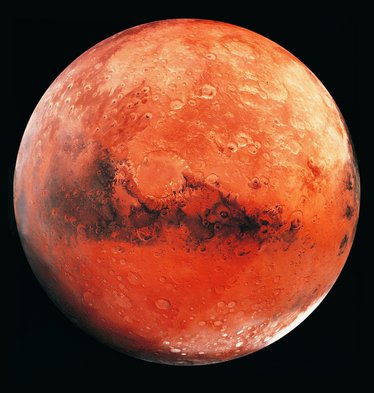(单词翻译:单击)
听力文本
This is Scientific American — 60-Second Science. I'm Steve Mirsky.
"Absolutely spectacular mission...and it's not a rover, it's a lander. It's designed to land and deploy several instruments."
Jim Green, NASA's new chief scientist, talking about the InSight Mission to Mars. InSight (Interior Exploration using Seismic Investigations, Geodesy and Heat Transport) launched from Vandenberg Air Force Base in California the morning of May 5th. He spoke with Scientific American space editor Lee Billings, who recorded their conversation.
"One instrument...will be set on the surface and will measure Marsquakes. Now why are Marsquakes important? Well, Marsquakes, because we can get the acoustic signals and see how they are displayed in time, we can tease out the size of the core, even if it's liquid or not, the size of the mantle and the crust, and compare those with the big terrestrial planet, Earth, that we know a lot about its interior. And this will really help us understand how terrestrial planets are made."
Green was NASA's Planetary Science Division director since 2006 before taking on his current assignment just last week. Back to the InSight Mission.

"But in general, it also has a human exploration part to it. For instance, we know Mars is quaking, we have seen with Mars Reconnaissance Orbiter, from orbit, avalanches. And so, something is going on and it's shaking the planet. And this is really exciting, because if humans go to Mars in our lifetime, which I anticipate they will, they're gonna need to build structures. Those structures have got to be able to understand the environment and be safe. And so they're gonna have to withstand whatever Marsquake environment is actually there. We will know what that is, we will know if it's difficult or whether it's relatively easy, but we'll be able to accommodate it no matter what."
"Now another experiment is a heat probe. This also sits on the surface and it pounds into the ground about five meters a set of thermistors that will measure the heat...and that will tell us how Mars is cooling off. You know, all our planets were built 4.5 billion years ago, they're still cooling off from their initial accretion. So we're going to see, well, gee, is like Earth's geothermal ability, does Mars have an ability to, as it cools off, heat habitats for human exploration, or is it primarily very cool in the core, and we'll know if it's partially liquid or not, is that completely solid now. And all that will be put together in our models of the interior of Mars and as I said, it will also have some profound effects on what we do with human explorations next."
If all goes well, InSight will land on Mars on November 26th.
For Scientific American — 60-Second Science. I'm Steve Mirsky.
参考译文
这里是科学美国人——60秒科学。我是史蒂夫·米尔斯基。
“这绝对是引人注目的任务,而且它不是探测器,而是着陆器。它被用来登陆并部署多台仪器。”
吉姆·格林是美国国家航空航天局新任首席科学家,以上是他谈及“洞察火星任务”时所说。5月5日上午,“洞察”号着陆器(通过地震调查、大地测量学及热传输实施内部探测)从加利福尼亚州范登堡空军基地发射。他与《科学美国人》太空编辑李·比林斯进行了交谈,比林斯录下了他们的谈话。
“一台仪器将被放在火星表面,测量火星地震。为什么火星地震如此重要?因为通过火星地震,我们可以得到声学信号,观察它们是如何及时显示的,我们可以梳理出地震核心的大小——无论它是否是液体,我们还可以分析出地幔和地壳的尺寸,并将其与地球这一大型类地行星进行比较,而我们对地球的内部构造有很多了解。这将真正帮助我们理解类地行星的形成过程。”
格林从2006年开始担任美国国家航空航天局行星科学部主任,上周接受了目前的职位。下面说回“洞察”号任务。
“但总的来说,这项任务也包含人类探索的部分。举例来说,利用火星勘测轨道飞行器,我们从火星轨道和雪崩中了解到火星正在震动,因此,某些正在发生的事情震动了地球。这令人非常振奋,因为如果人类在有生之年登陆火星——我预计这会实现——他们需要建造建筑。这些建筑必须能理解环境并保持安全。因此,这些建筑必须承受确实存在的火星地震环境。我们将了解具体情况,我们会知道那很难还是相对容易,但无论如何,我们都将有能力去适应。”
“另一个实验是热探针。这个仪器也将被放在火星表面,它将插入地下约5米深,然后仪器中的一套热敏电阻将测量热度,并告诉我们火星的降温方法。所有行星都在45亿年前形成,它们从最初的吸积过程至今一直在降温。因此,我们将了解,就像地球的地热能力一样,火星在降温过程中是否有能力为人类探索而加热聚居区,或者火星核心一开始是否非常冷,我们还将知道火星核心是否一开始部分为液体、而现在已经完全成为固体。上述一切都将整合放入我们的火星内部模型中,如我所说,这将对接下来人类探索的工作产生深远影响。”
如果一切顺利,“洞察”号将于11月26日登陆火星。
谢谢大家收听科学美国人——60秒科学。我是史蒂夫·米尔斯基。
译文为可可英语翻译,未经授权请勿转载!
重点讲解
重点讲解:
1. tease out 套取,套出,巧妙获得(信息或答案);
The teacher helped them tease out the meaning of the poem.
老师帮助他们弄清楚那首诗的含义。
2. take on 承担,接受(尤指艰巨工作或重大责任);
She was plucked from the corps de ballet to take on Juliet.
她从芭蕾舞团的伴舞队中被挖掘出来,担任朱丽叶这一角色。
3. cool off (使)变凉;(使)凉快下来;
Maybe he's trying to cool off out there in the rain.
可能他是想在雨里凉快一下。
4. put together 装配;组装;拼合;组合;
They asked her to put together a dummy for a new magazine.
他们让她为一本新杂志攒一份小样。


